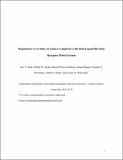| dc.contributor.author | Mack, Eric T. | |
| dc.contributor.author | Snyder, Phillip W. | |
| dc.contributor.author | Perez-Castillejos, Raquel | |
| dc.contributor.author | Bilgiçer, Başar | |
| dc.contributor.author | Moustakas, Demetri T. | |
| dc.contributor.author | Butte, Manish J. | |
| dc.contributor.author | Whitesides, George M. | |
| dc.date.accessioned | 2014-03-17T20:47:54Z | |
| dc.date.issued | 2012 | |
| dc.identifier.citation | Mack, Eric T., Phillip W. Snyder, Raquel Perez-Castillejos, Başar Bilgiçer, Demetri T. Moustakas, Manish J. Butte, and George M. Whitesides. 2012. Dependence of Avidity on Linker Length for a Bivalent Ligand–Bivalent Receptor Model System. Journal of the American Chemical Society 134, no. 1: 333–345. | en_US |
| dc.identifier.issn | 0002-7863 | en_US |
| dc.identifier.issn | 1520-5126 | en_US |
| dc.identifier.uri | http://nrs.harvard.edu/urn-3:HUL.InstRepos:11933748 | |
| dc.description.abstract | This paper describes a synthetic dimer of carbonic anhydrase, and a series of bivalent sulfonamide ligands with different lengths (25 to 69 Å between the ends of the fully extended ligands), as a model system to use in examining the binding of bivalent antibodies to antigens. Assays based on analytical ultracentrifugation and fluorescence binding indicate that this system forms cyclic, noncovalent complexes with a stoichiometry of one bivalent ligand to one dimer. This dimer binds the series of bivalent ligands with low picomolar avidities (Kdavidity = 3–40 pM). A structurally analogous monovalent ligand binds to one active site of the dimer with Kdmono = 16 nM. The bivalent association is thus significantly stronger (Kdmono/Kdavidity ranging from 500 to 5000 unitless) than the monovalent association. We infer from these results, and by comparison of these results to previous studies, that bivalency in antibodies can lead to associations much tighter than monovalent associations (although the observed bivalent association is much weaker than predicted from the simplest level of theory: predicted Kdavidity of 0.002 pM and Kdmono/Kdavidity 8 × 106 unitless). | en_US |
| dc.description.sponsorship | Chemistry and Chemical Biology | en_US |
| dc.language.iso | en_US | en_US |
| dc.publisher | American Chemical Society | en_US |
| dc.relation.isversionof | doi:10.1021/ja2073033 | en_US |
| dc.relation.hasversion | http://gmwgroup.harvard.edu/pubs/pdf/1138.pdf | en_US |
| dash.license | OAP | |
| dc.title | Dependence of Avidity on Linker Length for a Bivalent Ligand–Bivalent Receptor Model System | en_US |
| dc.type | Journal Article | en_US |
| dc.description.version | Author's Original | en_US |
| dc.relation.journal | Journal of the American Chemical Society | en_US |
| dash.depositing.author | Whitesides, George M. | |
| dc.date.available | 2014-03-17T20:47:54Z | |
| dc.identifier.doi | 10.1021/ja2073033 | * |
| dash.contributor.affiliated | Whitesides, George | |
| dc.identifier.orcid | 0000-0001-9451-2442 | |


